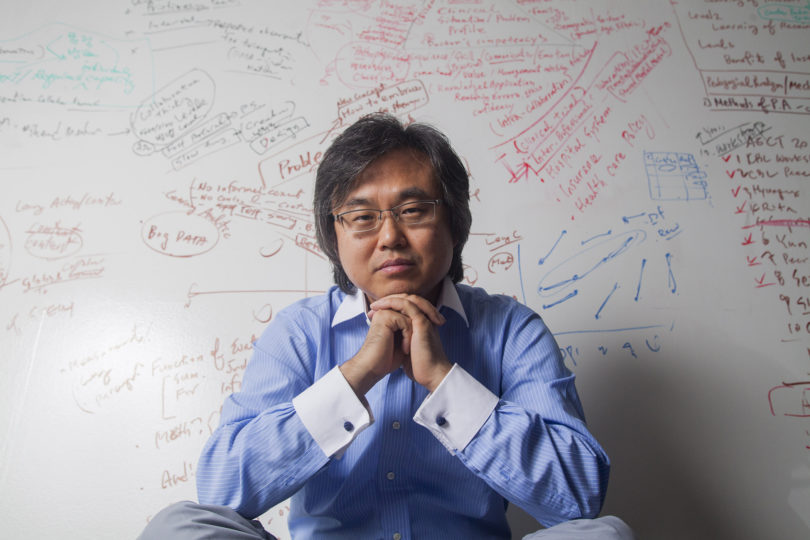The first thing you notice about Ikseon “Ike” Choi’s office at River’s Crossing is that he uses an entire wall, from floor to ceiling, as a giant whiteboard.
Covering the wall in writing of various colors, Choi keeps track of his ideas, pondering how people learn and how technology can unpack even more knowledge.
“I have always been interested in understanding human beings,” said the South Korea native. “I realized that learning is an essential part of human lives.”
Choi’s interest in computers as learning tools led him to eventually seek a doctorate in instructional systems.
“When I was younger, I thought technology could play a larger part in human life in the future. But I didn’t choose the path of studying technology, I chose to study the path of humanity—how to integrate technology to advance human lives,” he said.
Choi is a faculty member in the College of Education’s Learning, Design and Technology program, which prepares students to design and implement lesson plans and training programs for all levels of learners. He teaches graduate courses in learning theories, real-world problem solving and reasoning, learning-environment design and e-learning evaluation.
“Our goal is to prepare professionals to identify and analyze learning problems and then create and implement effective solutions to support learning and performance in its place,” he said.
Through his multidisciplinary collaborations with leading scholars in teacher education, agricultural science, engineering, and in both human and animal medicine, Choi’s research has sought the most effective ways to promote and evaluate the development of learners’ real-world problem-solving abilities.
“There is a gap between what we teach in school and how students are supposed to perform in the real world,” Choi said. “Textbook knowledge is not enough for them to know how to deal with real-world problems.”
Choi focuses on integrating complex situations, the kind faced in the real world, into the classroom.
To this end, Choi developed an interactive learning tool, the “Case-Based E-Learning Module to Enhance Veterinary Students’ Diagnostic and Therapeutic Decision Making,” to help third-year veterinary students hone critical thinking skills and practice making difficult medical decisions. The students use the Web-based tool to diagnose difficult cases, and then hear the diagnoses faculty members would make on the same cases.
Choi developed this particular version of the tool with UGA College of Veterinary Medicine faculty members Karen Cornell, Kate Creevy, MaryAnn Radlinsky and Chad Schmiedt.
Choi also is leading a UGA partnership with the South Korean educational robotics firm RoboRobo to bring $23,000 worth of robotics education kits into elementary school classrooms in Barrow, Clarke and Jackson counties.
He and his colleagues are developing new robotic education programs. The school-based research site brings together faculty members and graduate students to work with area teachers to develop robotics workshops customized for specific classroom needs.
Robotics provides opportunities for students to think more deeply and to relate their problem-solving strategies to the real world, Choi said. He believes the introduction of robotics education will draw more students into science and technology fields.
But Choi has a larger, global vision of what could be done with robotics after a recent visit to Haiti.
“What if we create a robust, affordable and integrated science, technology, engineering and math, or STEM, curriculum with robotics, and distribute this high-quality learning experience on a global scale to help the children in developing countries?” he asked. “In Haiti, they need to develop a lot of human resources for technology and engineering positions if they are going to develop their economy.
“The kids there are eager to learn to use technology,” he said. “I could see the excitement in their eyes and a great vision for their future.”
And another idea goes on the whiteboard.








